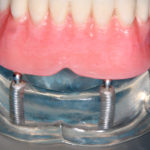
The two-implant overdenture is an effective treatment option for patients with an edentulous mandible. A number of different attachment systems are available to increase retention including bar, ball, magnets, and stud. While different systems have different requirement selection is often based on clinical experience and preference. However, variation in implant and overdenture survival and prosthetic complications between the systems has been reported.
The aim of this review was to assess the effectiveness of different attachment systems for complete edentulous mandibular Implant-supported overdentures (IODs)
Methods
A protocol was registered in the PROSPERO database. Searches were conducted in the Cochrane Library, Embase, Medline/PubMed, and Scopus databases supplements by hand searches in the last 6 months in prosthodontics and oral implantology journals. Randomised controlled trials (RCTs) published in English reporting on the survival of dental implants and IOD prostheses were considered.
Five reviewers participated in study selection and data abstraction. Risk of bias was assessed based on 5 domains, randomisation process, deviations from intended interventions, missing outcome data, measurement of the outcome, and selection of the reported result. The primary outcome measure was the survival rate of implants and mandibular IODs.
Results
- 25 RCTs involving a total of 1064 patients (2525 implants) were included.
- Follow up times ranged from 12 to 120 months.
- 23 studies contributed to the meta-analyses.
- In 23 studies involving 2154 dental implants, 36 implant failures were identified.
- 18 studies involving 737 overdentures reported 43 failures or re- makes.
- Meta-analyses of failure rates for implants, overdentures and different attachment types are shown in the table below.
| No. of studies | Failure rate (95%CI) | |
| Implants | 23 | 2.0% (1.3% to 3.2%) |
| Overdentures | 18 | 4.2% (1.6% to 10.5%) |
| Bar type attachments | 13 | 7.7% (3.0% to 18.1%) |
| Ball type attachments | 22 | 6.8% (3.0% to 14.3%) |
| Magnetic attachments | 7 | 7.6% (2.2% to 22.7%) |
- No significant difference was found in biological complications for splinted and unsplinted implant overdentures.
Conclusions
The authors concluded: –
Implant and overdenture prostheses have a high survival rate in the edentulous mandibular arch, and attachment systems did not significantly affect the survival rates.
Biological complications did not differ significantly in splinted and unsplinted implant overdenture groups.
Prosthetic complications were more commonly observed in magnets and least commonly observed in the LOCATOR group. Bars, in general, had lower complication rates than ball attachments in mandibular IODs.
Comments
The authors pre-registered their protocol on the PROSPERO database and searched a number of major databases. However, the restriction to English language publications may have excluded some relevant studies.A number of other recent reviews have looked at various aspects mandibular overdentures (see other references below) with a 2018 Cochrane review (Dental Elf – 17th Oct 2018) looking at the effectiveness of mandibular overdentures concluding,
For mandibular overdentures, there is insufficient evidence to determine the relative effectiveness of different attachment systems on prosthodontic success, prosthodontic maintenance, patient satisfaction, patient preference or costs.
The authors of this review included 25 RCTs in total only 4 of which were included in the Cochrane review also only one of the 25 included studies has been published since the Cochrane review. While the reviews identified some bias concerns in 14 studies overall, they rated all 25 as having low risk of bias. Interestingly all 4 studies that were also included in the Cochrane review were rated as being at high risk of bias in one or more domains. The minimum follow-up period for the included studies was 12 months 11 out of the 25 studies (44%) being followed up for 60 months or longer. This review as with others suggests there is little difference between the effectiveness of the difference mandibular overdenture attachments systems available. However the quality of the available evidence should be improved.
Links
Primary Paper
Prasad S, Faverani LP, Santiago Junior JF, Sukotjo C, Yuan JC. Attachment systems for mandibular implant-supported overdentures: A systematic review and meta-analysis of randomized controlled trials. J Prosthet Dent. 2022 Sep 14:S0022-3913(22)00485-1. doi: 10.1016/j.prosdent.2022.08.004. Epub ahead of print. PMID: 36115712.
Other references
Dental Elf – 17th Oct 2018
Dental Elf – 10th Feb 2020
Overdentures: The effect of attachment systems on clinical performance
Dental Elf – 21st Mar 2022
Implant-supported overdentures and fixed prostheses in edentulous mandibles
Dental Elf – 20th Jan 2023
Picture Credits
By Coronation Dental Specialty Group[1] – Own work, CC BY-SA 3.0, Link
